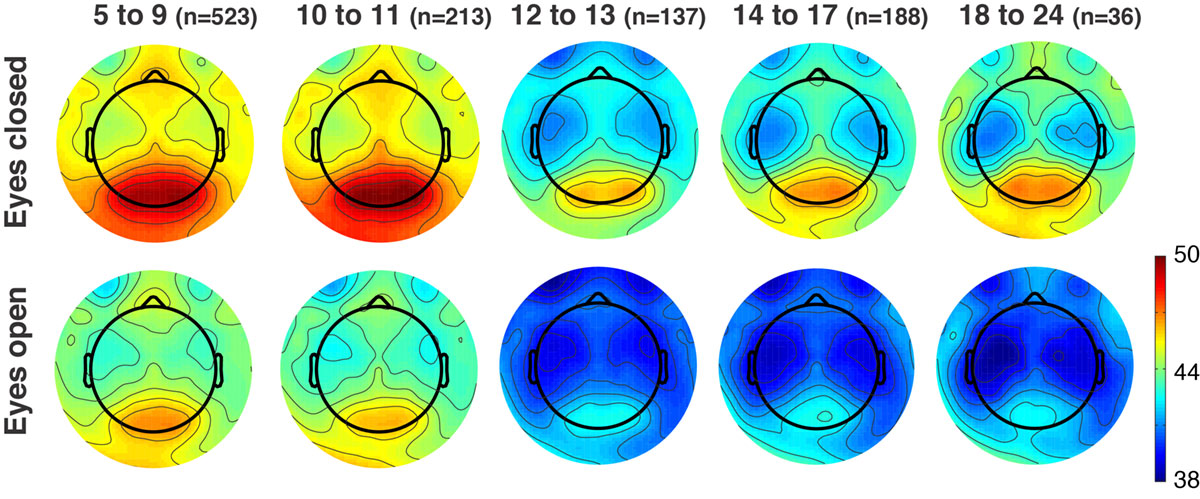

 Skip to navigation
Skip to navigation
Site Primary Navigation:
- About SDSC
- Services
- Support
- Research & Development
- Education & Training
- News & Events
Search The Site:

Published April 1, 2019

Results of processing 2,194 128-channel EEG datasets from the Child Mind Institute database. Alpha power (color unit, relative power in dB) decreases with age (age groups in years shown in columns) in both eyes open and closed conditions (rows). The EEG processing here was performed purely as a proof of concept to illustrate the potential of using high performance computing (HPC) resources for hypothesis discovery and testing in EEG neuroimaging. Credit: Delorme, A., Majumdar, A., Sivagnanam, S., Martinez-Cancino, R., Yoshimoto, K., Makeig, S. (2019) The Open EEGLAB portal. IEEE transactions on biomedical engineering (2019 NER conference). San Francisco, CA. March 20-23, 2019.
By Kimberly Mann Bruch, SDSC Communications
Even though electroencephalography (EEG) has been used for almost 100 years, this safe and painless test of brain activity remains an efficient method for recording aspects of rapid brain activity patterns supporting our thoughts and actions. Leveraging the power of the Comet supercomputer at the San Diego Supercomputer Center (SDSC) at UC San Diego, campus researchers have demonstrated they can efficiently analyze more than 1,000 EEG 128-channel high-density data sets via the new Open EEGLAB Portal running on SDSC’s Neuroscience Gateway (NSG).
Developed by Arnaud Delorme, Ramon Martinez, and Scott Makeig of UC San Diego’s Swartz Center for Computational Neuroscience (SCCN) in collaboration with SDSC researchers Amitava Majumdar, Subhashini Sivagnanam, and Kenneth Yoshimoto, a first report on the Open EEGLAB portal was presented at the March 2019 International IEEE EMBS Conference on Neural Engineering in San Francisco.
In this report, Delorme and Makeig build on their collaboration with the Child Mind Institute Healthy Brain Network (HBN) project to demonstrate how high-performance computing (HPC) can be used for effective analysis of large EEG datasets. To date, difficulties in relating scalp recordings to activities in specific brain structures, individual differences in head and brain shapes and sizes, and difficulty in harnessing sufficient computer power have discouraged researchers from attempting sophisticated source-level analysis of very large data sets.

Arnaud Delorme of UC San Diego’s Swartz Center for Computational Neuroscience (SCCN) presenting at the March 2019 International IEEE EMBS Conference on Neural Engineering in San Francisco.
With a goal of better understanding human brain development, the HBN project is currently collecting brain scans and EEG recordings, as well as other behavioral data from 10,000 New York City children and young adults – the largest such sample ever collected.
“We hope to use portals such as the EEGLAB to process this data so that we can learn more about biological markers of mental health and learning disorders in our youngest patients,” said HBN Director Michael Milham.
The report by Delorme and colleagues demonstrates that source-level analyses of brain dynamics are now feasible and can become routine in the near future, as continuing advances in machine learning methods are applied to an ever wider range of biological data.
“One of the key players of our study was UC San Diego undergraduate student Brian Rojas, who determined how to efficiently download the Child Mind data and set it up on Comet for processing,” said Majumdar. “Brian, who is funded by the National Science Foundation’s SciGap project, has been learning about NSG’s backend software and usage modes of neuroscientists as they use NSG, helped us develop and execute the data download processing script on Comet.”
Delorme, Makeig, and Majumdar hope to be able to tie the EEGLAB Portal and NSG to the growing National Institutes of Health (NIH) human brain imaging data archive, under a recent proposal. “The initiative would create a portal for archiving and analyzing EEG and related data collected from the NIH and other research projects around the world,” explained Delorme. “The Child Mind data now being analyzed at SDSC is an important seed for the envisioned archive.”
The Open EEGLAB Portal project is supported by NIH grant 5R01EB023297.
About SDSC
As an Organized Research Unit of UC San Diego, SDSC is considered a leader in data-intensive computing and cyberinfrastructure, providing resources, services, and expertise to the national research community, including industry and academia. Cyberinfrastructure refers to an accessible, integrated network of computer-based resources and expertise, focused on accelerating scientific inquiry and discovery. SDSC supports hundreds of multidisciplinary programs spanning a wide variety of domains, from earth sciences and biology to astrophysics, bioinformatics, and health IT. SDSC’s petascale Comet supercomputer is a key resource within the National Science Foundation’s XSEDE (eXtreme Science and Engineering Discovery Environment) program.
Share